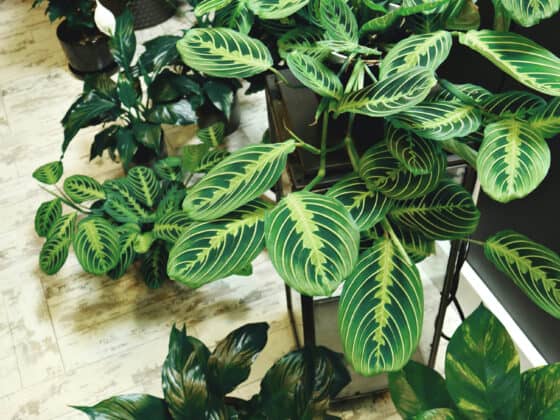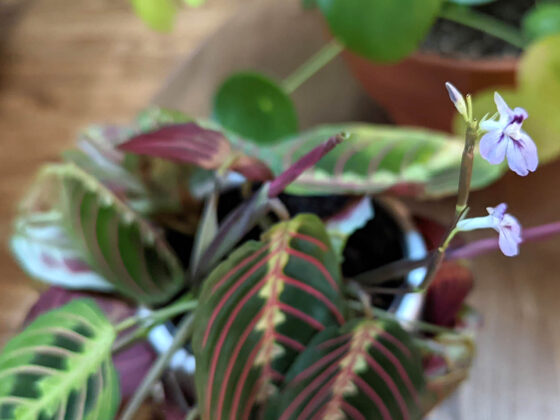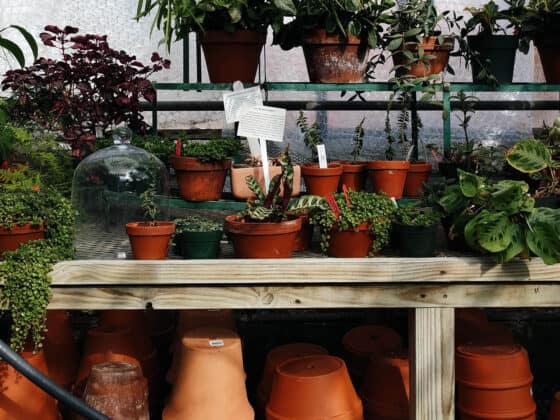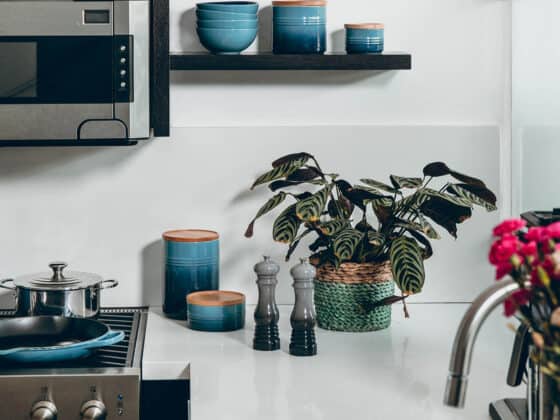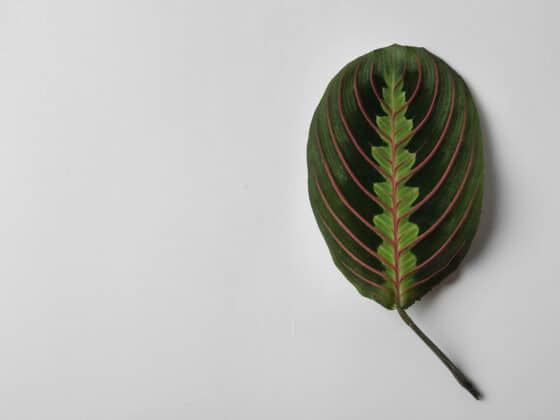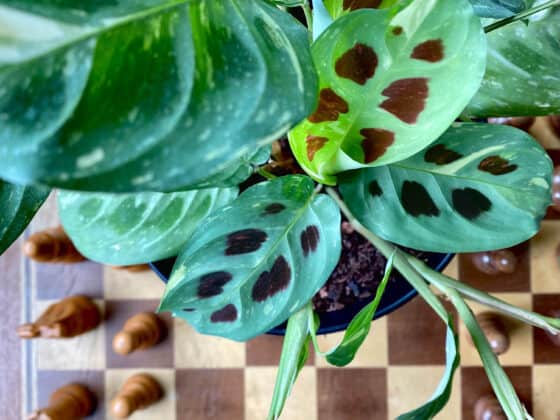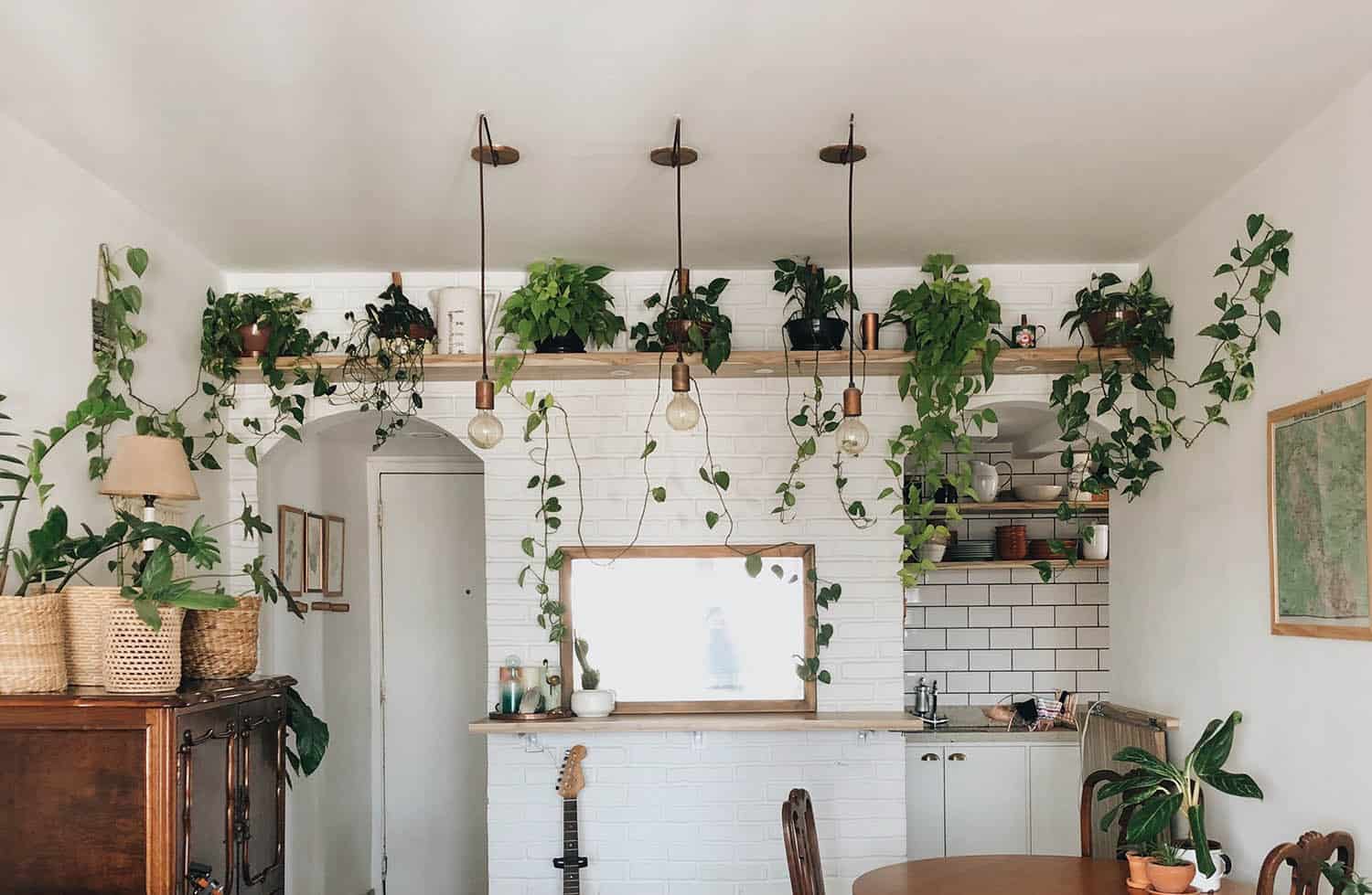One of the most appealing aspects of Maranta leuconeura, aka Prayer Plant, is how its leaves move and “dance” as light changes throughout the day. Unlike some plants that seem to just sit there, month after month, the frequent movement of the Prayer Plant gives the feeling of having a living thing in your home. When you view this plant at various times of day, you can see different angles of the leaves and stems, providing an appealing visual interest.
All Prayer Plants have the potential to move and pray, but sometimes they inexplicably stop moving. It can be alarming to observe any change in a previously healthy houseplant, so use this as a chance to diagnose possible problems with your Maranta. The most likely reasons for a Prayer Plant to stop moving are incorrect light levels (too much or too little), insufficient water, or shock.
Do not panic if your Maranta leuconeura moves less than usual or stops moving. A Prayer Plant doesn’t need to move and pray to be healthy! But if you are wondering how and why this plant (and many others) move and what can cause them to stop, some of the most common reasons are listed below.
An Overview of Prayer Plant Movement
Before we determine why your Prayer Plant may not be standing up the way you expect, let’s go through a brief explanation of why and how the leaves move. Marantas and many other plants move their leaves in response to darkness. This behavior is called nyctinastic movement. There are various types of nastic movement, which is simply the name for a plant’s reaction to a stimulus such as light, temperature, or touch.
Prayer Plant movement mimics the circadian rhythm, following a 24-hour cycle. Some early scientists studying nyctinasty believed that the plants were doing something similar to sleeping at night. The reality is that plants don’t experience waking and sleep in the way animals do. Holding their leaves upward could be considered a more active position than having them down and open, so this wouldn’t even be a logical resting position. Instead, botanists have several theories about what survival advantage the plant might be getting from this behavior.
Most of the ideas about why plants demonstrate nyctinastic movement are related to light, water, temperature, or all three. Since leaves absorb both sunlight and humidity from the air around them, it seems reasonable to think that they could move to regulate the amount of moisture or solar radiation the plant receives. We see similar behavior in other types of plants, such as flowers that open in the day and close up at night or plants that track the sun as it moves.
Maranta leuconeura adjusts the position of its leaves and stems through the function of a motor organ called the pulvinus. The amount of liquid in the cells of the pulvinus causes each cell to swell or contract. The swollen cells cause that area of the plant to stiffen and raise, while the opposite allows stems and leaves to relax back into their open position.
For a more detailed explanation of how Prayer Plants and their relatives move, check out this article: When, Why, and How Do Prayer Plants Move and “Pray”?
Do All Prayer Plants Pray?
Aside from Maranta leuconeura, several members of the Marantaceae family are sold as houseplants, including Stromanthe, Calathea (recently renamed Goeppertia), and Ctenanthe. You may see any of these being labeled or referred to as Prayer Plant, although only Maranta leuconeura is actually a Prayer Plant.
You can expect nyctinasty to show up in all of these plants, although the degree of movement can vary from plant to plant. Typically, Maranta leuconeura movement is the most noticeable, but the conditions in your home influence how much your specific plant moves.
If you have another plant from the Marantaceae group that is not moving, the advice will be mostly the same. They tend to require similar care, so you can use the troubleshooting tips below, even if yours is not a Prayer Plant.
For more information on the different Marantaceae and how to identify them, this article goes into the topic in much more detail: Prayer Plant Varieties: Which Prayer Plant Do You Have?
Most Common Reasons for Prayer Plants Not Praying or Moving
Before you start to diagnose why your Prayer Plant is not moving, evaluate whether or not there is an actual problem. Is this a new situation, or has your Maranta been still since you got it? Are there any other apparent problems, such as discolored or drooping leaves? If your plant otherwise looks healthy, it doesn’t need to move its leaves and stems.
Also, be sure you have reasonable expectations for what Prayer Plant movement looks like. Check some photos or videos online to see what the range of motion is. For example, don’t expect the leaves to fold in on themselves like a closing book or to curl in from the sides. Instead, the regular “prayer” movement can be just a few lifted leaves that are angled more vertically than they are during the daytime.
Reason #1: Too Little Light
As mentioned above, there is a theory that the reason for Marantas’ movement is to adapt to the available light levels. If this theory is correct, and the plant is not getting enough light during the day, it might not raise its leaves at night. By leaving them open and flat, the plant would maximize the amount of light it can take in, even during the evening and night hours.
Other signs that your Maranta isn’t getting enough light include pale leaves and slow growth. Prayer Plants are often sold as low light plants, and they can survive for a while in low light conditions, but they will not thrive there long-term.
Try moving your Prayer Plant to a spot that gets medium indirect light or adding a grow light if you do not have an appropriate window for it. Be sure to keep Marantas out of direct sun, though, as their delicate leaves can quickly get burned.
Reason #2: Too Bright at Night
Nyctinastic movement is a response to darkness (not light), which makes it a different response than when other plants grow toward the sun. Plants display all sorts of nastic movements, depending on the type of stimulus causing the movement. If your plant is kept in a bright place all the time, it may not raise its leaves at night.
Marantas that sit near a bright streetlight or in offices where fluorescent lighting stays on 24/7 are likely to stay in their daytime position. Since they never get the stimulus of darkness, they never express the nyctinastic movement fully.
You should easily be able to determine if this is the reason your Prayer Plant isn’t praying. Just relocate it to a room that gets dark at night and observe whether that causes a change to the behavior.
Reason #3: Not Enough Moisture
Prayer Plants require consistently moist (but not wet) soil. Unlike some other plants that bounce back once watered, Marantas can show permanent leaf damage if they get too dry – even if it’s for a short time.
Keep an eye out for a Prayer Plant that looks just slightly more limp than usual. This is the first sign that the potting mix is too dry, so if you can catch it at this point, your plant shouldn’t suffer much (if any) damage. Try to anticipate your Prayer Plant’s needs and not let it dry out.
A dry Maranta leuconeura will stop moving or praying because they need sufficient liquid in the cells in the pulvinus to operate. You are likely to observe other signs in conjunction with this one if your Prayer Plant is too dry. The leaves start to look shriveled or curl in on themselves, and the whole plant gets droopy.
Also, note that Prayer Plants can be a bit picky about their water. The best choice is room-temperature rainwater. Water that is too warm or cool can cause shock (see below), and tap water sometimes causes brown leaf edges because it contains minerals. Distilled water also works if you don’t have access to rainwater.
Reason #4: Environmental Changes
Even if you haven’t consciously changed anything about the way you care for your Prayer Plant, it could be reacting to environmental factors like lower light or humidity due to changing seasons. Many houseplants can adapt to seasonal changes without us noticing since those changes occur gradually over time.
Marantas are more high-maintenance than some other plants, though, and they don’t like any alterations to their environment. Your plant may just need time to adjust to the different conditions, but you can play around with adjusting light and humidity to see if that brings the plant back to normal.
When a plant reacts poorly to changes in its environment, the general term is “plant shock” (different from transplant shock, covered below). It’s easier to avoid plant shock than to fix it, so try to avoid changes as much as you are able, or introduce those changes to your Prayer Plant gradually. That way, the plant can adapt to the changing conditions without experiencing shock.
Reason #5: Transplant Shock
Related to the reason above, Prayer Plants sometimes have a bad reaction to being repotted. Unfortunately, unlike some other environmental changes, there’s no way to repot a plant gradually. One of the reactions to repotting you might encounter is a reduction in the amount of movement the Prayer Plant displays. Dramatically wilting and curling leaves usually accompany transplant shock.
If you have recently moved your Maranta leuconeura to a larger container, it is getting a sudden boost of nutrients from the potting mix, plus the roots may have suffered a bit of damage in the move. It is a good idea to water thoroughly 24 hours before you interact with a Prayer Plant’s roots in any way, to minimize damage to the root hairs.
If you suspect transplant shock, there are not too many things you can do other than wait. During this recovery time, be sure your Prayer Plant has all its other care needs met (temperature, humidity, watering) while it devotes its energy to getting healthy. Remove any dead or dying leaves as they sap resources from the plant.
Putting it All Together
Maranta leuconeura leaves open and close due to changes in the light levels in its environment. In general, healthy Prayer Plants in the right conditions will move their leaves and stems throughout the day. However, they do not have to move to be doing well.
That said, any time your plant’s behavior and appearance changes, it is a good indication that you should evaluate what happened. Most of the time, if your Maranta leuconeura stops moving because of some problem, this will not be the only symptom. If nothing else, Marantas are quite communicative since they show their displeasure right away if something is wrong.
The most common reasons your Prayer Plant stops moving and praying include too much or too little light, the potting mix getting too dry, or a reaction to shock. It could also be a combination of a couple of these. Luckily, it should be simple to determine what caused your plant to stop moving. Once you have identified the issue, you can move forward with the correct steps to get your Prayer Plant back to its normal, healthy movement!







